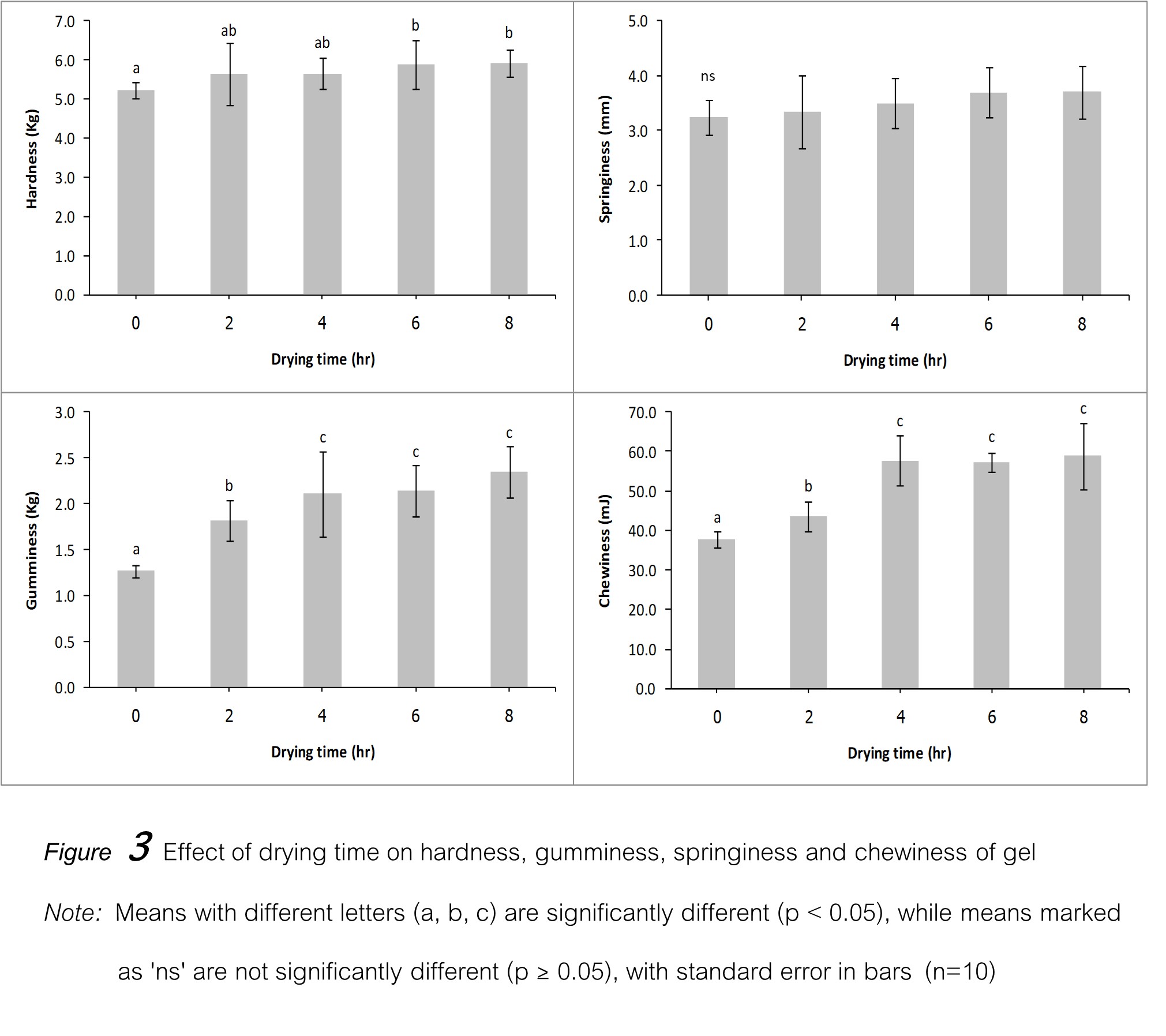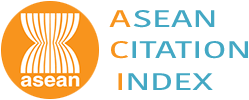ผลของคาร์ราจีแนนและกลูโคแมนแนนต่อเยลลี่น้ำเชื่อมจาก และความเป็นไปได้ในการพัฒนาเป็นกัมมี่เยลลี่ปราศจากเจลาติน
คำสำคัญ:
น้ำเชื่อมจาก , เจล, คาร์ราจีแนน , กลูโคแมนแนนบทคัดย่อ
วัตถุประสงค์และที่มา : น้ำเชื่อมจากเป็นผลิตภัณฑ์ที่ได้จากน้ำหวานของต้นจาก โดยผ่านกระบวนการเคี่ยวเพื่อลดปริมาณน้ำจนมีค่าของแข็งที่ละลายน้ำได้ทั้งหมดประมาณ 60-70 องศาบริกซ์ แต่การที่อยู่ในรูปน้ำเชื่อมอาจไม่สะดวกในการรับประทานโดยตรง ดังนั้นหากนำน้ำเชื่อมจากมาพัฒนาเป็นผลิตภัณฑ์เยลลี่จะทำให้สะดวกแก่การบริโภคมากยิ่งขึ้น การใช้คาร์ราจีแนน (CG) ร่วมกับกลูโคแมนแนน (GM) สามารถสร้างเจลที่มีความเสถียรทางโครงสร้างเพิ่มขึ้น ช่วยให้เจลมีความแข็งแรงและสามารถเก็บกักน้ำได้ดี จึงเหมาะสำหรับผลิตภัณฑ์ประเภทเยลลี่และกัมมี่เยลลี่ งานวิจัยนี้จึงมีวัตถุประสงค์เพื่อศึกษาคุณภาพของน้ำเชื่อมจาก และการใช้ไฮโดรคอลลอยด์ทั้ง 2 ชนิดที่มีผลต่อการผลิตเยลลี่น้ำเชื่อมจากโดยวิเคราะห์จากสมบัติทางเคมี กายภาพ และประเมินทางประสาทสัมผัส นอกจากนี้การใช้ไฮโดรคอลลอยด์จากพืชสามารถนำมาใช้ในผลิตภัณฑ์กัมมี่เยลลี่ปราศจากเจลาตินได้ด้วย ดังนั้นจึงศึกษาความเป็นไปได้ในการผลิตกัมมี่เยลลี่น้ำเชื่อมจากที่ปราศจากเจลาติน เพื่อสร้างมูลค่าเพิ่มให้กับน้ำเชื่อมจากเป็นผลิตภัณฑ์ที่เหมาะสมกับผู้บริโภคในปัจจุบัน
วิธีดำเนินการวิจัย : วิเคราะห์คุณภาพน้ำเชื่อมจากด้วยการวัดค่า pH ปริมาณกรด น้ำตาล ความชื้น ของแข็งที่ละลายน้ำได้ วอเตอร์แอกติวิตี (aw) ค่าสี (L*, a* และ b*) และความหนืด นำสูตรพื้นฐานเยลลี่ที่ได้จากการค้นคว้างานวิจัยที่เกี่ยวข้องและทดลองผลิตเบื้องต้นมาผลิตเป็นเยลลี่น้ำเชื่อมจาก (ไม่ได้แสดงผล) โดยมีส่วนผสมของน้ำ น้ำเชื่อมจาก น้ำตาลทราย น้ำตาลทรายแดง กรดซิตริก และโซเดียมซิเตรตร้อยละ 74.1, 15.0, 9.0, 1.0, 0.4 และ 0.5 ตามลำดับ เติม CG และ/หรือ GM ลงไปร้อยละ 1 ของส่วนผสมทั้งหมด ศึกษาอัตราส่วน CG:GM (ตั้งแต่ 10:0 ถึง 0:10) ที่มีผลต่อเจลเยลลี่น้ำเชื่อมจาก นำมาวิเคราะห์สมบัติทางเคมี (ค่า pH ปริมาณกรด และความชื้น) กายภาพ (ค่าสี และค่าเนื้อสัมผัส) และประเมินทางประสาทสัมผัส การวัดค่าเนื้อสัมผัส (TPA) วัดด้วยเครื่องวัดเนื้อสัมผัสที่มีกำลังโหลดเซลล์ 10 กิโลกรัม โดยวัดค่าความแข็ง ความยืดหยุ่น ความเหนียว และการเคี้ยว คำนวณด้วยโปรแกรมประมวลผล ประเมินทางประสาทสัมผัสโดยพิจารณาจากลักษณะปรากฏ สี กลิ่น เนื้อสัมผัส รสชาติ และความชอบโดยรวม กับผู้ทดสอบชิมจำนวน 30 คน โดยใช้แบบประเมินความชอบ 9 Point hedonic scale ตั้งแต่ 1 (ไม่ชอบมากที่สุด) ถึง 9 (ชอบมากที่สุด) ศึกษาปริมาณน้ำเชื่อมจากที่เหมาะสม (ร้อยละ15-25) นำมาวิเคราะห์สมบัติทางเคมี ค่าสี และประเมินทางประสาทสัมผัส และศึกษาความเป็นไปได้ในการผลิตกัมมี่เยลลี่น้ำเชื่อมจากที่ปราศจาก เจลาตินโดยทดสอบผลการอบแห้งเยลลี่ที่อุณหภูมิ 60 องศาเซลเซียส เป็นเวลา 0-8 ชั่วโมง แล้วนำมาวิเคราะห์สมบัติทางเคมี และค่าเนื้อสัมผัส
ผลการวิจัย : ผลการวิจัยพบว่าน้ำเชื่อมจากมีค่า pH 5.21 ค่า aw 0.80 ความชื้นร้อยละ 31.69 กรดทั้งหมดร้อยละ 1.26 น้ำตาลรีดิวซ์ร้อยละ 28.09 น้ำตาลทั้งหมดร้อยละ 78.27 และของแข็งที่ละลายน้ำได้ทั้งหมด 67.8 องศาบริกซ์ มีค่าสี L* 56.41, a* 21.15 และ b* 34.37 และมีค่าความหนืด 135.3 cPs การใช้ CG:GM ในอัตราส่วน 6:4 ทำให้ได้เจลเยลลี่น้ำเชื่อมจากที่มีค่าความแข็ง ความยืดหยุ่น ความเหนียว และการเคี้ยวเพิ่มขึ้นเมื่อวัดโดยใช้เครื่องวัดเนื้อสัมผัส และมีผลการประเมินทางประสาทสัมผัสด้านความชอบโดยรวมในระดับชอบปานกลางถึงชอบมากจากผู้ทดสอบชิม แต่ไม่แตกต่างอย่างมีนัยสำคัญทางสถิติ (p ≥ 0.05) กับการใช้อัตราส่วน 8:2 เยลลี่น้ำเชื่อมจากที่ใช้ปริมาณน้ำเชื่อมจากที่ร้อยละ 20.0 มีค่า pH 4.06 ปริมาณกรดร้อยละ 0.65 ความชื้นร้อยละ 71.75 และค่าสี L*, a* และ b* มีค่าเท่ากับ 21.96, 2.62 และ 3.97 ตามลำดับ ได้รับคะแนนความชอบโดยรวมสูงสุด (7.73) อยู่ในระดับชอบปานกลางถึงชอบมาก การอบลมร้อนที่อุณหภูมิ 60 องศาเซลเซียส เป็นเวลา 6 ชั่วโมง ช่วยลดความชื้นในเจล ทำให้เนื้อสัมผัสมีความแข็ง ความเหนียว และการเคี้ยวเพิ่มขึ้น ขณะที่ค่า pH และปริมาณกรดคงที่ เจลที่ได้มีลักษณะเป็นกัมมี่เยลลี่ ที่มีความเหนียว เคี้ยวได้ง่ายและไม่แข็งจนเกินไป วิธีการอบแห้งนี้แสดงให้เห็นถึงความเป็นไปได้ในการผลิตกัมมี่เยลลี่น้ำเชื่อมจากที่ปราศจากเจลาติน
สรุปผลการวิจัย : งานวิจัยนี้แสดงให้เห็นว่าน้ำเชื่อมจากที่ได้จากน้ำหวานต้นจากสามารถนำมาพัฒนาเป็นผลิตภัณฑ์เยลลี่น้ำเชื่อมจากได้ โดยใช้น้ำเชื่อมจากร่วมกับไฮโดรคอลลอยด์ 2 ชนิด ได้แก่ CG และ GM เพื่อสร้างเจลที่มีโครงสร้างเสถียร และมีเนื้อสัมผัสที่ดี ได้ผลิตภัณฑ์มูลค่าเพิ่มจากน้ำเชื่อมจาก และความเป็นไปได้ในการผลิตกัมมี่เยลลี่ที่ปราศจากเจลาติน ผลการวิเคราะห์น้ำเชื่อมจากพบว่ามีค่า pH 5.21 ความชื้นร้อยละ 31.69 น้ำตาลรีดิวซ์ร้อยละ 28.09 น้ำตาลทั้งหมดร้อยละ 78.27 และความหนืด 135.3 cPs เมื่อพัฒนาเยลลี่ด้วยการปรับอัตราส่วน CG:GM พบว่าอัตราส่วน 6:4 ให้เจลที่มีความแข็ง ความยืดหยุ่น ความเหนียว และการเคี้ยวที่เหมาะสมโดยได้คะแนนความชอบโดยรวมจากผู้ทดสอบชิมมากที่สุด อยู่ในระดับชอบปานกลางถึงชอบมากแต่ไม่แตกต่างกับการใช้อัตราส่วน 8:2 การใช้น้ำเชื่อมจากร้อยละ 20 ให้เยลลี่ที่มีค่า pH 4.06 ความชื้นร้อยละ 71.75 และได้คะแนนความชอบโดยรวมสูงสุด ส่วนการผลิตกัมมี่เยลลี่ พบว่าการอบลมร้อนที่อุณหภูมิ 60 องศาเซลเซียส เป็นเวลา 6 ชั่วโมง ช่วยลดความชื้นในเจล ทำให้เนื้อสัมผัสมีความแข็ง ความเหนียว และการเคี้ยวเพิ่มขึ้น โดยค่า pH และปริมาณกรดไม่เปลี่ยนแปลง ผลลัพธ์นี้แสดงให้เห็นถึงศักยภาพในการพัฒนาน้ำเชื่อมจากให้เป็นผลิตภัณฑ์เยลลี่และกัมมี่เยลลี่ที่ปราศจากเจลาติน และสามารถเพิ่มมูลค่าให้กับน้ำเชื่อมจากในเชิงพาณิชย์ได้
เอกสารอ้างอิง
AOAC. (2005). Official Method of Analysis. (18th Ed.). Maryland : Association of Official Analytical Chemists International.
Apirattananusorn, S. (2021). Effect of heating processes on physical and chemical properties of syrup from sap of nipa palm (Nypa fruticans Wurmb.). Sugar Tech, 23(4), 907-914.
Baiti, Q.A.N., Salsabila, Z., Apsari, W., Ramadan, M.B., Karen, E., Valencia, Sahid, M.N.A., Darsih, C. , & Laksitorini, M.D. (2024). The development of plant-based jelly candy for Chrysanthemum indicum L. flower extract and evaluation of the antioxidant activity. Indonesian Journal of Pharmacy, 35(2), 292-304.
Belova, N.M., Kutsenkova, V.S., Petrova, O.N., Popova, O.M., Yeganehzad, S. , & Nepovinnykh, N.V. (2021). New insights into grain hydrogels with reinforced textural properties: design of low-calorie jelly desserts technology. IOP Conference Series: Earth and Environmental Science, 723, 032066 (1-8).
Board, E. (2012). Hand book of confectionery with formulations. New Delhi : Engineers India Research Institute.
Cebin, A., Bunić, M., Jarić, A.,Šeremet, D., & Komes, D. (2024). Physicochemical and sensory stability evaluation of gummy candies fortified with mountain germander extract and prebiotics. Polymers, 16, 259 (1-25).
Delgado, P. , & Bañón, S. (2015). Determining the minimum drying time of gummy confections based on their mechanical properties. CyTA- Journal of Food, 13(3), 329-335.
Edwards, W.P. (2000). The Science of sugar confectionery. London : Royal Society of Chemistry.
Imeson, A.P. (2009). Carrageenan and furcellaran. In G.O. Phillips & P.A. Williams. (Eds.), Handbook of hydrocolloids. (pp. 164-185). (2nd Ed.). Cambridge : Woodhead Publishing Limited and CRC Press LLC.
Kaenin, J., Pongsetkul, J., Thavarang, P., Kaesang, T., & Takeungwongtrakul, S. (2020). Development of strawberry dessert jelly fortified with collagen hydrolysate. Burapha Science Journal, 25(1), 117-128. (in Thai)
Li, Y., Li, K., Guo, Y., Liu, Y., Zhao, G., Qiao, D., Jiang, F., & Zhang, B. (2024). Mechanism for the synergistic gelation of konjac glucomannan and κ-carrageenan. International Journal of Biological Macromolecules, 277, 134423 (1-9).
Mathlouthi, M. (2001). Water content, water activity, water structure and the stability of foodstuffs. Food Control, 12(7), 409-417.
Mutlu, C., Tontul, S.A., & Erbaş, M. (2018). Production of a minimally processed jelly candy for children using honey instead of sugar. LWT Food Science and Technology, 93, 499-505.
Pechillo, D., & Izzo, M. (1996). The Use of carrageenan and cellulose gel in gummi candy. The Manufacturing Confectioner, 76(11), 62-66.
Phetrit, R., Chaijan, M., Sorapukdee, S., & Panpipat, W. (2020). Characterization of nipa palm’s (Nypa fruticans Wurmb.) sap and syrup as functional food ingredients. Sugar Tech, 22(1), 191-201.
Ranganna, S. (1986). Handbook of analysis and quality control for fruit and vegetable products. (2 nd. ed.). India : Tata McGraw-Hill publishing company.
Rochmawati, N., & Ermawati, D.E. (2012). The effect of carrageenan concentration on the physical and chemical properties of gummy turmeric acid Jamu. Majalah Farmaseutik, 17(2), 230-237.
Saengkrajang, W., Chaijan, M., & Panpipat, W. (2021). Physicochemical properties and nutritional compositions of nipa palm (Nypa fruticans Wurmb) syrup. NFS Journal, 23, 58-65.
Saengkrajang, W., Thanonthip, P., Nounmusig, J., & Suhem, K. (2020). Effect of gelling agents on quality attributes of durian jelly. Phranakhon Rajabhat Research Journal (Science and Technology), 15(2), 141-155. (in Thai)
Suankramdee, W., Jirakachaporn, B., & Harnsilawat, T. (2022). Effect of carrageenan and drying time on selected qualities of gummy jelly. In Proceedings of 60th Kasetsart University Annual Conference: Science, Engineering and Architecture, Agro-Industry, Natural Resources and Environment. (pp. 455-460). Pathum Thani (Thailand) : Prachacheun Research Network. (in Thai)
Suwan, T., Narathapanon, P., Lamsuwan, A., Pongpattanapanich, W, & Kullamethee, P. (2018). Development of Babbler’s Bill leaf carragenan jellies. The Journal of KMUTNB, 28(2), 403-411. (in Thai)
Thanaratikul, P. (2022). Effect of carrageenan on quality of germinated soybean jelly. Journal of Science and Science Education, 5(2), 215-224. (in Thai)
Thai Industrial Standards Institute. (2024).Thai industrial standards institute standards of jelly. TISI 263-2566. (in Thai)
Tinakorn Na Ayutthaya, K., & Putduang, N. (2016). The Product Development of Healthy Cereal Jelly. The Journal of Food Technology Siam University, 11(1), 13-20. (in Thai)
Tye, R.J. (1991). Konjac flour: Properties and application. Food Technology, 45(3), 86-92.
Utomo, B.S.B., Darmawan, M., Rahman, A.H., & Ardi, D.T. 2014. Physicochemical properties and sensory evaluation of jelly candy made from different ratio of -carrageenan and konjac. Squalen Bulletin of Marine & Fisheries Postharvest & Biotechnology, 9(1), 25-34.
Wang, R. & Hartel, R.W. (2022). Citric acid and heating on gelatin hydrolysis and gelation in confectionery gels. Food Hydrocolloids, 129, 107642 (1-14).
Zheng, M., Wei, Y., Jiao, X., Jiang, Z., Li, Z., Ni, H., & Zhu, Y. (2024). Effects of konjac glucomannan with different molecular weights on functional and structural properties of -carrageenan composite gel. Food Biophysics, 19, 553-566.

ดาวน์โหลด
เผยแพร่แล้ว
รูปแบบการอ้างอิง
ฉบับ
ประเภทบทความ
สัญญาอนุญาต
ลิขสิทธิ์ (c) 2025 คณะวิทยาศาสตร์ มหาวิทยาลัยบูรพา

อนุญาตภายใต้เงื่อนไข Creative Commons Attribution-NonCommercial-NoDerivatives 4.0 International License.
Burapha Science Journal is licensed under a Creative Commons Attribution-NonCommercial-NoDerivatives 4.0 International (CC BY-NC-ND 4.0) licence, unless otherwise stated. Please read our Policies page for more information



